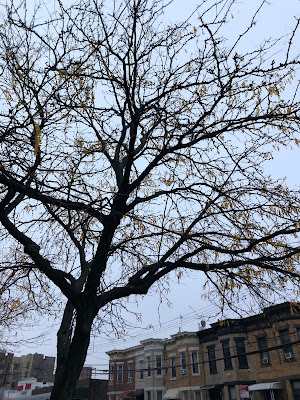This weekend included a change of seasons and cultures--and rides.
While, officially, we're deep into Fall, from Thursday through the middle of Saturday, it felt more like early summer. I took Friday's ride, to Connecticut, in what I might wear around Memorial Day or Labor Day--a pair of shorts and a fluorescent green T-shirt. The breeze took some of the edge off the humidity.
Saturday morning, I pedaled out to Kesso's for some fresh Greek yogurt. Alas, they were closed. I hope everything is OK there: Perhaps they, like so many other shops--and people--couldn't get some thing or another they needed because of the interrupted supply chains that have emptied store shelves. Later in the day, wind drove hard rain against leaves, windows and faces.
Yesterday, the wind let up--for a little while--and temperatures were more fall-like. I took a spin along the North Shore of Queens and western Nassau County, which took me into a neighborhood frequented by almost nobody who doesn't live there--in spite of its proximity to a mecca for in-the-know food enthusiasts.
On a map, College Point is next to Flushing. But the two neighborhoods could just as well be on diffeent planets. The latter neighborhood, one of the city's most crowded, has been known as the "Queens Chinatown" for the past three decades or so. There are dozens of places where one can sample a variety of regional cuisines, and have everything from a formal dining experience to chow on the run. Those places are centered around Roosevelt Avenue and Main Street, at the end of the 7 line of the New York subway system--and one stop away from Citi Field, the home of the New York Mets, and the US Tennis Center, site of the US Open and other events.
College Point is "off the grid," if you will--away from the city's transit systems and accessible only by winding, narrow streets that dead-end in inconvenient places or truck-trodden throughfares that, at times, resemble a moonscape, that weave through industrial parks, insular blue-collar communities and views of LaGuardia Airport and the Manhattan skyline one doesn't see in guidebooks.
Until recently, College Point--which, pervesely, includes no college--was populated mostly by the children and Irish, German and Italian construction workers and city employees who were the children, grandchildren and great-grandchildren of Irish, German and Italian construction workers and city employees. Their houses were smaller versions of the nearby factories and warehouses: squat brick structures framed by latticeworks of steel or wooden trellises, cornices and fences.
In that sense, this place fits right in:
The New York Hua Lian Tsu Hui Temple is--you guessed it--a square brick building framed with wooden cornices and a steel fence. The cornices, though, are different: They signal the purpose of the building, and signify other things. Apparently, Chinese and Korean people who needed more space to raise their kids--or simply wanted to escape the crowding of Flushing--have "discovered" the neighborhood.
Some have families and pets:
Marlee, though, was not impressed! All she knows is that when I'm on my bike (or doing anything outside the apartment), I'm not there for her to curl up on.





































